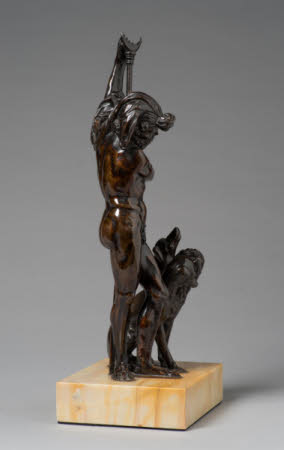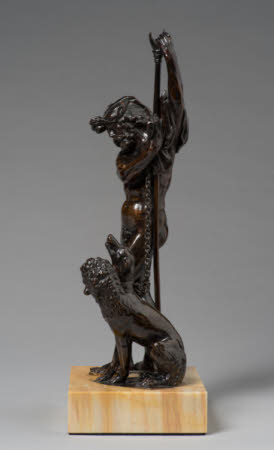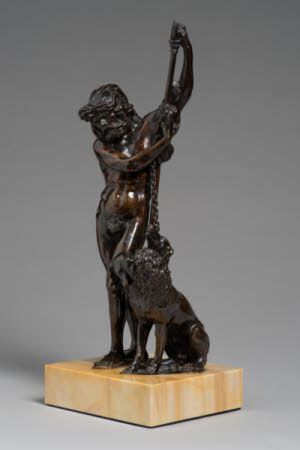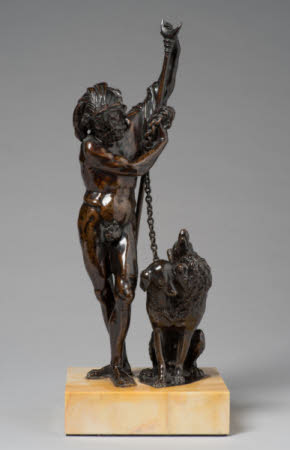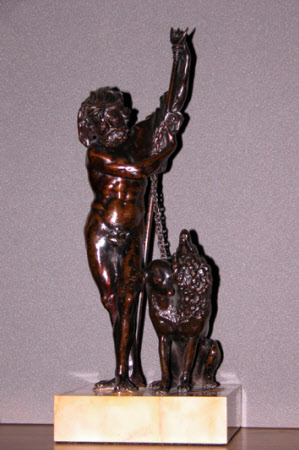Pluto, god of the Underworld, with his hound Cerberus
French School
Category
Art / Sculpture
Date
c. 1550 - c. 1580
Materials
Bronze
Measurements
337 mm (Height)
Place of origin
France
Order this imageCollection
Anglesey Abbey, Cambridgeshire
NT 515019
Summary
Bronze, Pluto, French School, c. 1550-1580. A bronze figure of Pluto, god of the underworld, standing naked except for an elaborate turban-like head-covering, which cascades down his left arm. Pluto’s body is twisted with his left leg placed forward; right arm raised high to hold the crescent-shaped end of a long staff. His other hand holds a chain fastened at other end to the collar around the neck of one of the three heads of Pluto’s three-headed hound, Cerberus, which guarded the entrance to the underworld. Of the three canines making up this particular Cerberus, all are hunting dogs; the first two are a generic hunting dog and a greyhound, whilst the third is a more unusual breed, a water-spaniel. The surfaces of the bronze figures are very carefully worked, for example the light punching in Pluto’s headdress and in the dogs’ coats. The surface is an intense golden colour beneath a blackish lacquer. Pluto’s fig leaf appears to be a later addition. The separately cast figures of Pluto and Cerberus are now mounted on a giallo antico yellow marble socle.
Full description
We do not know when Lord Fairhaven acquired this exceptional bronze, one of the finest small bronze statuettes in the collection at Anglesey Abbey. The figure is not only well modelled and cast, but its surfaces have been very carefully worked after casting, with tools such as files, small chisels and punches. It retains much of its rich golden colouring under a coating of black lacquer. Pluto was the Greek god of the underworld. His proper name was in fact Hades, the name also given to his underground realm, which lay on the further shore of the River Styx, across which the dead were rowed by the ferryman Charon. The entrance to Hades was guarded by a ferocious three-headed hound, Cerberus. For the Greeks, Hades was a grey and sombre place inhabited by ghosts; in subsequent mythology the notion grew of a separate region, Elysium, a pleasant land reserved for heroes and the righteous, whilst the wicked were condemned to Tartarus, a place of torture. The bronze is closely derived from an engraving by Gian Jacopo Caraglio (1500/05-1565), published in 1526 as part of a series of standing gods in niches, after designs by Rosso Fiorentino (1494-1540) and Perino del Vaga (1501-47). Caraglio’s print of the god Pluto is based on a drawing by Rosso, now in the Musée des Arts Décoratifs, Lyons (Inv. 447/a. Eugene A. Carroll, Rosso Fiorentino. Drawings, Prints and Decorative Arts, exh. cat., National Gallery of Art, Washington 1987, pp. 96-97, no. 19; Thierry Crépin-Leblond and Vincent Droguet, eds., Le Roi et l’Artiste. François Ier et Rosso Fiorentino, exh. cat., Château de Fontainebleau, Paris 2013, pp. 66-67, no. 10). The print (Carroll, p. 106, no. 27) follows the drawing very closely, but also carries the inscription .PLVTONEM. MAGNVM. MIRANTVR. QVAM. TARTARA. REGEM. (‘They stand in awe of great Pluto, as they do of his realm of Tartarus’). The series of images of the gods, with their daring poses of nude male and female figures placed against niches, were immensely popular throughout the sixteenth century and beyond, being copied and reissued numerous times. They were also extensively mined as a source for designs for decorative art objects in sixteenth-century France, with the figures of the gods reappearing on Limoges painted enamels and on cupboards and other furniture (Jacques Thirion, ‘Rosso et les Arts Décoratifs’. Revue de l’Art, 13 (1971), pp. 32-47, esp. pp. 33-40). There is a group of related small bronze statuettes of Pluto, all essentially based on Rosso’s and Caraglio’s design, but in fact differing somewhat from the Anglesey Abbey Pluto,. The principal examples are those in the Metropolitan Museum of Art, New York (Invs. 25.142.10 and 1978.516.60; Geneviève Bresc-Bautier, Guilhem Scherf and James David Draper, eds., Cast in Bronze. French Sculpture from Renaissance to Revolution, exh. cat., Musée du Louvre, Paris, Metropolitan Museum of Art, New York, J. Paul Getty Museum, Los Angeles, Paris 2009, pp. 70-73, nos. 2A & B), the Victoria & Albert Museum, London (Inv. A.114-1910) and the Herzog Anton-Ulrich Museum, Brunswick (Invs. Bro 41 and 42; Ursel Berger and Volker Krahn, Bronzen der Renaissance und des Barock, Braunschweig 1994, nos. 32-33). Among these, the best version is the second of the two in New York, the only one to retain the figure of Cerberus, who is equipped with the heads of a spaniel, lion and a wolf, but also with a fish-like tail. The New York bronze may well be identifiable with the version of the model recorded in the collection of Cardinal de Richelieu after his death in 1642, and later in the collections of his niece the duchesse d’Aiguillon and the sculptor François Girardon (1628-1715). These bronze versions however differ quite substantially from the Anglesey Abbey statuette. They show Pluto naked, looking downwards to his left and with his right hand held behind his back. In all of them the spear or trident, on which he would have been leaning, is now missing, whilst in the first of the two versions in New York, Pluto seems to have been holding a pomegranate behind his back. The pomegranate is a reference to Pluto’s wife Proserpine, whose eating of the fruit led to her unhappy marriage to the god of the underworld. Compared to the Anglesey Abbey model, these bronzes move away to a significant degree from the Rosso/Caraglio print. In fact, they are as closely based on the celebrated antique marble figure of the Farnese Hercules, which at that time was easily viewable in Rome, in the courtyard of the Palazzo Farnese. The Anglesey Abbey Pluto on the other hand follows more closely the model of the print, in the general pose of Pluto, the unusual form of the trident, with its curved prongs, and the turban-like headdress worn by the god. At the same time, it too diverges from the print source in some important respects, notably the portrayal of Pluto as a mature or elderly bearded man (Pluto’s head can hardly be seen in the print) and the removal of Cerberus from between Pluto’s legs to a position to his left. When compared to the broader group of bronze statuettes of Pluto, the Anglesey Abbey version appears unquestionably the finest, the quality of the modelling and finishing extremely high. The bronze surface has been given a blood-red lacquer and over this is a layer of blackish patination, a type of surface treatment found on other French bronzes from the sixteenth and early seventeenth centuries. No less remarkable than the fine characterisation of Pluto is the exceptionally individualised depiction of Cerberus, with its three canine heads. As well as a generic hunting hound, a greyhound (French lévrier) and a water-spaniel (barbet) are easily identifiable. The model for the raised head of the greyhound, and possibly that for the hunting dog, seems to be a woodcut which appeared in the first volume of Conrad Gessner’s influential Historiae Animalium, first published in 1551. A rather similar group of hunting dogs, including a water spaniel, may be seen in the right-hand corner of Benvenuto Cellini’s magnificent bronze relief of the Nymph of Fontainebleau, now in the Musée du Louvre, Paris (John Pope-Hennessy, Cellini, London 1985, pp. 132-40, Plate 69). Cast in 1543, the lunette is the most significant surviving element, other than his famous Salt Cellar now in Vienna, of the works carried out by Cellini for King François I during his stay in France between 1540 and 1545. As well as Cellini, numerous other Italian artists were brought to by François I to work on the palace at Fontainebleau and other royal projects, notably Francesco Primaticcio (1504-70) and Rosso Fiorentino (1495-1540), the artist who provided the drawings for the series of prints of the gods. Primaticcio and Rosso were responsible for the paintings and stucco work that partly survive at the château of Fontainebleau, and for the development of the mannerist style known as the First School of Fontainebleau. The little statuette of Pluto fits very well within this Italianate and mannerist idiom. Whereas the other small bronze statuettes of the god discussed above are generally dated to around 1600 or into the seventeenth century, this superbly-modelled and -finished bronze is likely to date from the sixteenth century. Jeremy Warren, 2020
Provenance
Bequeathed to the National Trust in 1966 by Huttleston Rogers Broughton, 1st Lord Fairhaven (1896-1966) with the house and the rest of the contents.
Credit line
National Trust Collections (Anglesey Abbey, The Fairhaven Collection)
Makers and roles
French School, sculptor
References
Christie, Manson & Woods 1971: The National Trust, Anglesey Abbey, Cambridge. Inventory: Furniture, Textiles, Porcelain, Bronzes, Sculpture and Garden Ornaments’, 1971, p. 128

